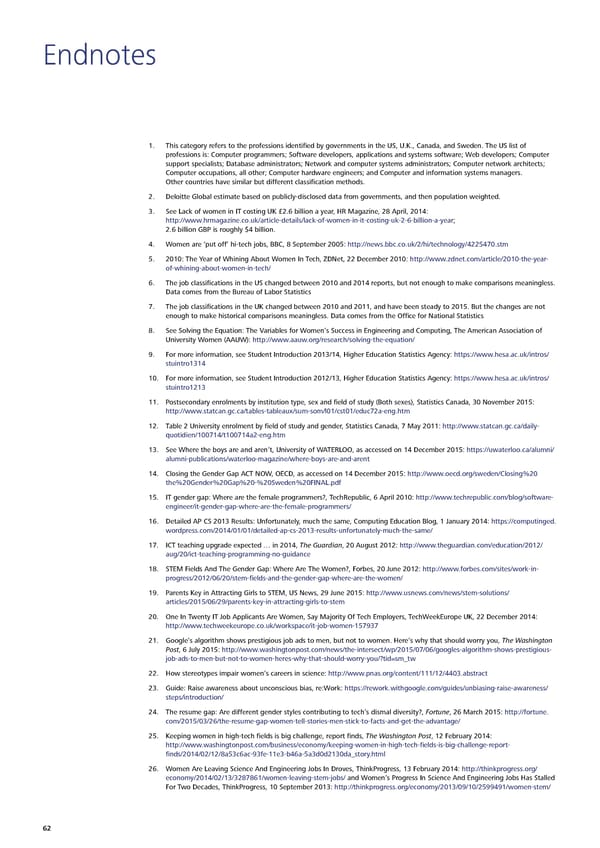Endnotes 1. This category refers to the professions identified by governments in the US, U.K., Canada, and Sweden. The US list of professions is: Computer programmers; Software developers, applications and systems software; Web developers; Computer support specialists; Database administrators; Network and computer systems administrators; Computer network architects; Computer occupations, all other; Computer hardware engineers; and Computer and information systems managers. Other countries have similar but different classification methods. 2. Deloitte Global estimate based on publicly-disclosed data from governments, and then population weighted. 3. See Lack of women in IT costing UK £2.6 billion a year, HR Magazine, 28 April, 2014: http://www.hrmagazine.co.uk/article-details/lack-of-women-in-it-costing-uk-2-6-billion-a-year; 2.6 billion GBP is roughly $4 billion. 4. Women are ‘put off’ hi-tech jobs, BBC, 8 September 2005: http://news.bbc.co.uk/2/hi/technology/4225470.stm 5. 2010: The Year of Whining About Women In Tech, ZDNet, 22 December 2010: http://www.zdnet.com/article/2010-the-year- of-whining-about-women-in-tech/ 6. The job classifications in the US changed between 2010 and 2014 reports, but not enough to make comparisons meaningless. Data comes from the Bureau of Labor Statistics 7. The job classifications in the UK changed between 2010 and 2011, and have been steady to 2015. But the changes are not enough to make historical comparisons meaningless. Data comes from the Office for National Statistics 8. See Solving the Equation: The Variables for Women’s Success in Engineering and Computing, The American Association of University Women (AAUW): http://www.aauw.org/research/solving-the-equation/ 9. For more information, see Student Introduction 2013/14, Higher Education Statistics Agency: https://www.hesa.ac.uk/intros/ stuintro1314 10. For more information, see Student Introduction 2012/13, Higher Education Statistics Agency: https://www.hesa.ac.uk/intros/ stuintro1213 11. Postsecondary enrolments by institution type, sex and field of study (Both sexes), Statistics Canada, 30 November 2015: http://www.statcan.gc.ca/tables-tableaux/sum-som/l01/cst01/educ72a-eng.htm 12. Table 2 University enrolment by field of study and gender, Statistics Canada, 7 May 2011: http://www.statcan.gc.ca/daily- quotidien/100714/t100714a2-eng.htm 13. See Where the boys are and aren’t, University of WATERLOO, as accessed on 14 December 2015: https://uwaterloo.ca/alumni/ alumni-publications/waterloo-magazine/where-boys-are-and-arent 14. Closing the Gender Gap ACT NOW, OECD, as accessed on 14 December 2015: http://www.oecd.org/sweden/Closing%20 the%20Gender%20Gap%20-%20Sweden%20FINAL.pdf 15. IT gender gap: Where are the female programmers?, TechRepublic, 6 April 2010: http://www.techrepublic.com/blog/software- engineer/it-gender-gap-where-are-the-female-programmers/ 16. Detailed AP CS 2013 Results: Unfortunately, much the same, Computing Education Blog, 1 January 2014: https://computinged. wordpress.com/2014/01/01/detailed-ap-cs-2013-results-unfortunately-much-the-same/ 17. ICT teaching upgrade expected … in 2014, The Guardian, 20 August 2012: http://www.theguardian.com/education/2012/ aug/20/ict-teaching-programming-no-guidance 18. STEM Fields And The Gender Gap: Where Are The Women?, Forbes, 20 June 2012: http://www.forbes.com/sites/work-in- progress/2012/06/20/stem-fields-and-the-gender-gap-where-are-the-women/ 19. Parents Key in Attracting Girls to STEM, US News, 29 June 2015: http://www.usnews.com/news/stem-solutions/ articles/2015/06/29/parents-key-in-attracting-girls-to-stem 20. One In Twenty IT Job Applicants Are Women, Say Majority Of Tech Employers, TechWeekEurope UK, 22 December 2014: http://www.techweekeurope.co.uk/workspace/it-job-women-157937 21. Google’s algorithm shows prestigious job ads to men, but not to women. Here’s why that should worry you, The Washington Post, 6 July 2015: http://www.washingtonpost.com/news/the-intersect/wp/2015/07/06/googles-algorithm-shows-prestigious- job-ads-to-men-but-not-to-women-heres-why-that-should-worry-you/?tid=sm_tw 22. How stereotypes impair women’s careers in science: http://www.pnas.org/content/111/12/4403.abstract 23. Guide: Raise awareness about unconscious bias, re:Work: https://rework.withgoogle.com/guides/unbiasing-raise-awareness/ steps/introduction/ 24. The resume gap: Are different gender styles contributing to tech’s dismal diversity?, Fortune, 26 March 2015: http://fortune. com/2015/03/26/the-resume-gap-women-tell-stories-men-stick-to-facts-and-get-the-advantage/ 25. Keeping women in high-tech fields is big challenge, report finds, The Washington Post, 12 February 2014: http://www.washingtonpost.com/business/economy/keeping-women-in-high-tech-fields-is-big-challenge-report- finds/2014/02/12/8a53c6ac-93fe-11e3-b46a-5a3d0d2130da_story.html 26. Women Are Leaving Science And Engineering Jobs In Droves, ThinkProgress, 13 February 2014: http://thinkprogress.org/ economy/2014/02/13/3287861/women-leaving-stem-jobs/ and Women’s Progress In Science And Engineering Jobs Has Stalled For Two Decades, ThinkProgress, 10 September 2013: http://thinkprogress.org/economy/2013/09/10/2599491/women-stem/ 62
 Technology, Media & Telecommunications Predictions Page 71 Page 73
Technology, Media & Telecommunications Predictions Page 71 Page 73